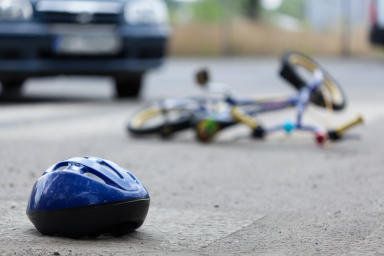California Bicycle Laws

California is a popular destination for bicycling enthusiasts from all over the world. With its beautiful scenery, warm climate, and miles of bike-friendly roads, it's no surprise that California is home to millions of bicyclists. Unfortunately, with this popularity comes an increased risk of accidents and injuries on the road. In fact, according to the National Highway Traffic Safety Administration (NHTSA), California has the highest number of bicycle fatalities in the country. In 2020, there were 155 bicyclist fatalities in California, which accounted for 11.4% of all traffic fatalities in the state. To help reduce the number of bicycle accidents and ensure the safety of bicyclists, the state of California has established a comprehensive set of laws governing bicycle use on public roads. This page will provide an overview of the essential California bicycle laws and safety guidelines that all bicyclists should be aware of before hitting the road.
California Helmet Law
California's helmet law requires all bicycle riders under 18 to wear a properly fitting and fastened helmet while riding a bicycle. The law applies to all road, bike paths, or sidewalk riders. Parents or guardians who knowingly allow their children to ride without a helmet may be fined. The first offense carries a fine of up to $25, and subsequent offenses carry penalties of up to $50.
While California's helmet law only applies to riders under the age of 18, it is recommended that all bicyclists wear helmets. Wearing a helmet can help reduce the risk of head injury in a bike accident.
It's important to note that the helmet law does not impact the legal rights of a bicycle accident victim. Even if a rider was not wearing a helmet at the time of the accident, they might still be entitled to compensation for their injuries if someone else's negligence caused the accident.
California Yield to Pedestrians Law
In California, bicyclists must yield to pedestrians in crosswalks and on sidewalks. For example, if a cyclist is approaching a crosswalk and a pedestrian is waiting to cross, the cyclist must yield the right-of-way to the pedestrian. Likewise, cyclists must yield to any pedestrians walking on the sidewalk if they ride on a sidewalk.
However, the "yield to pedestrians" law does not absolve pedestrians of their responsibilities. For example, pedestrians are also required to use crosswalks when they are available and to look both ways before crossing the street.
Failing to yield can result in a citation and a fine. In addition, if a cyclist hits a pedestrian while failing to yield, the cyclist may be liable for the pedestrian's injuries.
California Bike Lanes Law
Bicyclists are generally required to use bike lanes when they are present. However, there are some exceptions to this rule. Bicyclists may leave the bike lane when necessary to avoid hazards or make a left turn. For instance, if the bike lane is blocked by an obstacle, such as a parked car, the bicyclist may leave the bike lane to avoid the obstacle. Similarly, if the bicyclist needs to make a left turn, they may leave the bike lane to enter the left turn lane or cross the road.
Bicyclists who fail to use a bike lane when one is present and safe to do so may be fined and cited. However, bicyclists are not required to use a bike lane if doing so is unsafe or if there is no bike lane present.
Even if bicyclists use a bike lane, they still have the same rights and responsibilities as other vehicles on the road. Bicyclists must obey traffic signals and signs, yield the right-of-way when appropriate, and exercise caution when riding near pedestrians or other bicyclists.
Sharing the Road in California
Under California law, bicycles are considered vehicles and cyclists have the same rights and responsibilities as other drivers on the road. Here are some specific regulations and guidelines for bicyclists in California:
Bicyclists must ride in the same direction as traffic.
Bicyclists must use hand signals when turning or stopping.
Bicyclists are allowed to ride on the sidewalk, but local laws may vary.
Bicycles may ride two abreast on the road but must move into a single file when overtaken by a vehicle.
Motorists are required to give bicyclists at least three feet of space when passing.
Bicyclists can use the entire lane when necessary to avoid hazards or make a left turn.
California Rear Reflector and Lights Law
Bicyclists must have a red reflector on the rear of their bicycle, visible from a distance of at least 500 feet when illuminated by headlights. In addition to the rear reflector, bicyclists must also have a white headlight visible from the front of the bicycle from a distance of at least 300 feet.
Rear reflectors and lights can make bicyclists more visible to drivers, particularly in low-light conditions such as dusk or at night. This increased visibility can help prevent accidents by giving drivers more time to react and avoid collisions. In addition, these devices send a clear signal to drivers of their presence and movement. This can help prevent accidents by reducing the likelihood of confusion or miscommunication between drivers and bicyclists.
Riding Under the Influence
It is illegal for anyone to operate a bicycle while under the influence of alcohol or drugs, including prescription drugs or over-the-counter medications that impair their ability to ride safely. The legal blood alcohol concentration (BAC) limit for bicyclists in California is 0.08%, the same as for drivers of motor vehicles.
If bicyclists ride under the influence, they may be subject to fines, legal fees, community service, or jail time. In addition, their bicycle may be impounded, and they may lose their driver's licenses if they have one.
Bicyclists need to remember that riding under the influence is illegal and puts them and others at risk of severe injury or death. Bicyclists should always ride sober and make alternate arrangements if they plan to drink or use drugs.
How Much Can Someone Sue For a Bike Accident in California?
There is no set limit or cap on the amount someone can sue for a bicycle accident in California. Under California law, a person injured in a bicycle accident may seek compensation for various damages, including medical expenses, lost income, property damage, pain and suffering, and emotional distress. In some cases, the damages awarded can be significant, especially if the injuries are severe and the defendant's negligence or wrongdoing was particularly egregious.
The Statute of Limitations in California
The statute of limitations for bicycle accident lawsuits in California is generally two years from the date of the accident. This means that a person injured in a bicycle accident has two years from the date of the accident to file a lawsuit in court.
However, the statute of limitations can vary depending on the circumstances of the case on the events of the case. For example, if the person injured in the accident was a minor, the statute of limitations may be extended. The extension allows the minor to bring a lawsuit within two years of their 18th birthday rather than within two years of the date of the accident. The minor would have until their 20th birthday to file a lawsuit. It's important to note that this extension only applies to claims made by the minor themselves. If a parent or guardian wants to bring a claim on behalf of a minor, the standard two-year statute of limitations would still apply.
Other situations that may cause the statute of limitations to be extended — or, in some cases, shortened — include:
Discovery of injuries: If a person does not discover their injuries immediately after a bicycle accident, the statute of limitations may be extended. The clock starts running from the date the person discovers or should have discovered their injury.
Government entity claims: If the bicycle accident involves a government entity, such as a city or county, there are specific procedures and timeframes for filing a claim. The statute of limitations for a government entity claim may be as short as six months, and the process for filing the claim can be complicated.
Insanity or imprisonment: If a person is deemed legally insane or is imprisoned at the time of the accident, the statute of limitations may be tolled, or put on hold, until they are released or become legally competent.
Fraud or intentional misconduct: In cases where the defendant committed fraud or willful misconduct, the statute of limitations may be extended beyond two years.
Is California a no-fault state?
No, California is not a no-fault state. Instead, California is a "fault" state, which means that the person or party responsible for causing the accident is generally liable for the damages that result. In a bicycle accident, if a motor vehicle driver is at fault for the accident, they or their insurance company are responsible for paying damages to the injured person.
Legal Resources for California Bicycle Accident Victims
If you have been involved in a bicycle accident, you may wonder what legal resources are available to help you understand your rights and options. In California, there are a variety of resources that can provide guidance and support to individuals who have been involved in bike accidents. From government agencies to non-profit organizations to bar associations, many resources can help you navigate the legal process and seek compensation for your injuries. This list will highlight some of the top legal resources available to individuals involved in bicycle accidents in California.
California Bicycle Coalition
The California Bicycle Coalition (CalBike) is a non-profit advocacy organization that promotes bicycling and improves conditions for cyclists throughout California. CalBike's website offers a wealth of information on bicycle laws and regulations, as well as safety tips and advice for cyclists. They also provide advocacy tools and resources, such as model laws and policy proposals, to help promote safer conditions for cyclists in California.
In addition to their advocacy work, CalBike maintains a network of local chapters and affiliated organizations throughout the state, which can provide support and resources to bicycle accident victims at the local level.
While CalBike does not offer legal services directly, it can be a valuable resource for bicycle accident victims seeking to understand their legal rights and options. They can also provide referrals to attorneys and legal resources specializing in these cases.
California Courts
The California Courts website provides legal resources and information for Californians involved in bicycle accidents. The website includes information on how to file a lawsuit, court rules and procedures, and legal self-help resources. The site also provides a court locator tool and a range of court forms that can be used in civil cases, including personal injury cases arising from bicycle accident cases. While these resources can be helpful for individuals seeking to understand their legal rights and options, it's essential to consult with an experienced personal injury attorney who can provide guidance and representation based on your case's specific facts and circumstances.
California Department of Motor Vehicles
The California Department of Motor Vehicles (DMV) can be a helpful legal resource for bike accident victims in California. While the DMV is primarily known for its role in administering driver's licenses and vehicle registrations, it also provides a range of resources and information that can be helpful to individuals involved in bicycle accidents. Some ways the California DMV may be beneficial include providing information and resources on accident reporting, insurance requirements, traffic laws, driver safety, and driver education.
The State Bar of California
The State Bar of California is the organization that regulates the practice of law in California and serves as a helpful legal resource for bicycle accident victims. In addition, the California Bar Association, which is a part of the State Bar, provides a variety of resources for individuals who have been involved in bike accidents — including a lawyer referral service, legal help, ethical guidelines, and a process for filing complaints against attorneys who have engaged in unethical or unprofessional conduct.
Expertise.com StaffAuthor
Step into the world of Expertise.com, your go-to hub for credible insights. We don't take accuracy lightly around here. Our squad of expert reviewers, each a maestro in their field, has given the green light to every single article you'll find. From rigorous fact-checking to meticulous evaluations of service providers, we've got it all covered. So feel free to dive in and explore. The information you'll uncover has been stamped with the seal of approval by our top-notch experts.




